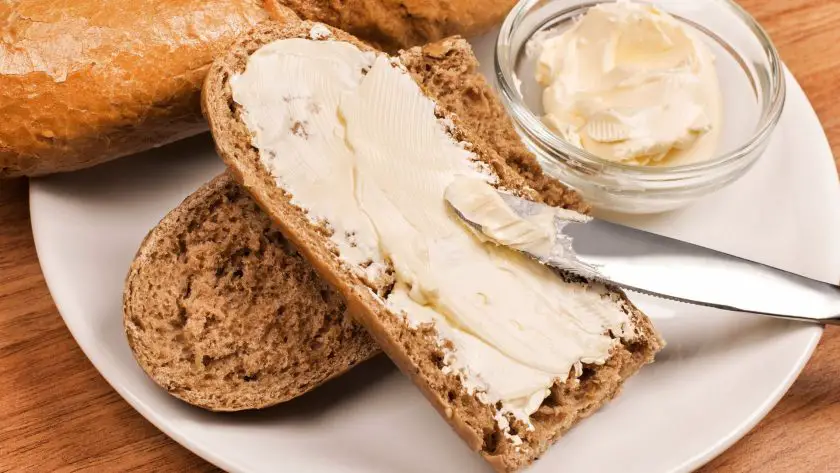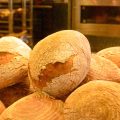Butterbrot is a beloved German breakfast staple, and it’s easy to replicate at home! Let’s get to creating this humble open-faced sandwich that will transport your senses to the charming streets of Germany.

Table of Contents
- Ingredients Needed
- Variations of Butterbrot
- Tips and Tricks for Great Butterbrot
- Yummy Serving Suggestions
- Other Popular German Sandwiches
- History and Origin
- Das ist Gut Butterbrot!
- How to Make Butterbrot: FAQs
Ingredients Needed
To make a delicious Butterbrot, you’ll need just a few simple ingredients that you likely already have in your kitchen. The beauty of this classic German dish lies in its simplicity and the quality of the components used.
- Bread
- 2 slices of hearty sourdough, rye, or your favorite type of bread
- Gluten-free or low-carb bread alternatives can be used for dietary restrictions
- Butter
- 1-2 tablespoons of high-quality, unsalted butter (softened)
- Vegan butter alternative or high-quality olive oil can be used for dairy-free options
- Herbs:
- 1 teaspoon of finely chopped chives
- 1 teaspoon of finely chopped parsley
Variations of Butterbrot
While the classic Butterbrot is a timeless favorite, there are countless ways to mix things up and create new, exciting variations. Let’s explore some delicious alternatives that will tantalize your taste buds and keep your Butterbrot game fresh and fun.
Das Wurstbrot (The Sausage Bread)
For a heartier twist on the traditional Butterbrot, try adding some thinly sliced German sausages like bratwurst, bockwurst, or even salami. The savory flavors of the meat pair perfectly with the rich butter and crusty bread. Top it off with a dollop of mustard for an extra kick.
Das Käsebrot (The Cheese Bread)
Cheese lovers, rejoice! A Käsebrot is a delightful way to indulge in your favorite dairy delight. Experiment with different types of cheese, from creamy brie to sharp cheddar or even a crumble of tangy blue cheese. For an added touch of sophistication, try drizzling a bit of honey over your creation.
Speaking of cheese bred, check out these sourdough recipes:
Das Marmeladenbrot (The Jam Bread)
If you’re in the mood for something sweet, a Marmeladenbrot is just the ticket. Spread your favorite jam or preserves over the butter for a fruity and indulgent treat. From classic strawberry to tart raspberry or exotic fig, the possibilities are endless. Sprinkle some toasted nuts on top for a delightful crunch.
Das Eierbrot (The Egg Bread)
For a protein-packed breakfast or brunch option, try an Eierbrot. Top your buttered bread with sliced hard-boiled eggs and a sprinkle of salt and pepper. You can also add a layer of crisp lettuce or peppery arugula for a fresh, green twist. This variation is sure to keep you fueled and satisfied throughout the day.
Tips and Tricks for Great Butterbrot
- Grill your bread lightly before adding toppings for a delightful crunch and subtle smoky flavor.
- Mix softened butter with finely chopped herbs like dill, parsley, or chives for a herbed butter spread.
- For a protein boost, try mashing some canned white beans with a fork and spreading it on your bread before adding other toppings.
- Drizzle some high-quality extra virgin olive oil over your assembled Butterbrot for added richness and flavor.
- Experiment with unique toppings like thinly sliced pears, crumbled blue cheese, and a drizzle of honey for a gourmet twist.
- Toast some nuts or seeds (like sunflower or pumpkin) and sprinkle them over your Butterbrot for added crunch and nutrition.
- For a vegan version, swap out the butter for mashed avocado seasoned with lemon juice, salt and pepper.
Yummy Serving Suggestions
Now that you’ve mastered the art of crafting the perfect Butterbrot, it’s time to explore the many ways you can serve and enjoy this delightful treat. Whether you’re looking for a quick breakfast on the go or a satisfying snack to tide you over between meals, Butterbrot has got you covered.
Butterbrot for Breakfast
Start your day off right with a hearty and wholesome Butterbrot. The combination of crisp, buttered bread and your favorite toppings will give you the energy boost you need to tackle whatever the morning throws your way. For a classic breakfast Butterbrot, try topping your creation with a slice of ham, a few cucumber rounds, and a sprinkle of chopped chives. Pair it with a steaming mug of coffee or tea, and you’ve got a breakfast that’s sure to satisfy.
Butterbrot as a Snack
When those mid-afternoon hunger pangs strike, reach for a Butterbrot to keep you going until dinnertime. The beauty of this versatile snack is that you can customize it to suit your cravings. Feeling peckish? Opt for a lighter Butterbrot with just a smear of butter and a few slices of radish. Need something more substantial? Load up your bread with cheese, sausage, or even a sliced hard-boiled egg. No matter how you slice it, Butterbrot makes for a tasty and convenient snack that’ll keep you fueled and focused throughout the day.
Pairing Suggestions
While Butterbrot is delicious on its own, it also plays well with others. Try serving your Butterbrot alongside a crisp green salad or a bowl of hearty soup for a well-rounded meal. If you’re in the mood for something sweet, pair your savory Butterbrot with a piece of fresh fruit or a dollop of jam on the side.
And of course, no Butterbrot is complete without a beverage to wash it down. Whether you prefer a cold glass of milk, a refreshing iced tea, or a bold cup of coffee, there’s a drink out there that’ll perfectly complement your Butterbrot creation.
Related: What to Eat With Sourdough Bread?
Other Popular German Sandwiches
While Butterbrot is a classic German sandwich, there are many other tasty sandwich options in German cuisine. Let’s take a look at some other popular German sandwiches that you might want to try.
Leberkäse Sandwich
The Leberkäse sandwich is a filling option that’s great for lunch or a snack. Leberkäse is a type of meatloaf made from beef, pork, and spices. It’s sliced and served on a soft roll, sometimes with mustard or pickles. Despite its name, which means “liver cheese,” there’s no liver or cheese in this sandwich.
Mettbrötchen
The Mettbrötchen is a unique sandwich that features raw minced pork seasoned with salt, pepper, and onions. It’s spread on a crusty roll and often eaten for breakfast or as a snack. While eating raw meat might seem strange, this sandwich is a well-loved part of German cuisine.
Fischbrötchen
If you’re near the coast, try a Fischbrötchen, which is a fish sandwich. It’s made with fried or pickled fish, like herring or mackerel, served on a soft roll with onions and remoulade sauce. The combination of fish, sauce, and bread makes for a tasty and refreshing meal.
Schnitzel Sandwich
The Schnitzel sandwich is a hearty and filling creation. A thin, breaded cutlet of veal or pork is fried until crispy and golden, then served on a roll. You can add toppings like sauerkraut, pickles, and mustard to make it your own.
History and Origin
Butterbrot holds a special place in Germany’s cultural heritage. With origins tracing back to the Middle Ages, this combination of bread and butter has evolved into a symbol of German practicality, frugality, and the importance of using high-quality ingredients.
The earliest known record of Butterbrot dates back to the 16th century when it was mentioned in a German cookbook. During the Industrial Revolution, Butterbrot became a popular snack among factory workers due to its portability and affordability. In the aftermath of World War II, when food was scarce, Butterbrot once again proved its value as a simple yet nourishing meal.
More than just a snack, Butterbrot is deeply ingrained in German traditions, from childhood memories to family rituals. The simplicity of the dish allows the flavors of artisanal bread and handcrafted butter to shine through, reflecting the craftsmanship of German bakers and dairy producers.
Butterbrot’s significance extends beyond everyday life, finding its way into literature, art, and popular culture as a metaphor for simplicity and authenticity. German author Johann Wolfgang von Goethe even mentioned Butterbrot in his works, cementing its place in the nation’s literary history.
As you create your own Butterbrot, it’s like participating in a cherished tradition that has stood the test of time, offering a deeper appreciation for Germany’s rich culinary heritage. Each bite connects you to generations of Germans who have enjoyed this humble yet satisfying dish.
Das ist Gut Butterbrot!
Butterbrot’s simplicity allows the flavors of high-quality ingredients to shine, reflecting the craftsmanship of German artisans.
Whether you prefer the classic version or a delicious variation, Butterbrot is a satisfying treat that offers a taste of Germany!
How to Make Butterbrot: FAQs
What are the ingredients in Butterbrot?
Butterbrot is a simple German sandwich made with only two ingredients: a slice of bread (usually a crusty white or whole grain bread) and butter. The bread is typically spread with a generous layer of butter. Butterbrot is often eaten as a breakfast food or as a light snack between meals.
Is Butterbrot a sandwich?
Yes, Butterbrot is considered a sandwich in Germany. Although it consists of only bread and butter, without any additional fillings, it still falls under the category of a sandwich due to its simple composition of bread with a spread. The straightforward nature of Butterbrot exemplifies the German preference for uncomplicated, wholesome foods.
Do Germans put butter on sandwiches?
Yes, Germans commonly put butter on their sandwiches. Butterbrot, a popular German sandwich, is made solely with bread and butter. Butter is a staple ingredient in German cuisine and is often used as a spread on bread for breakfast or as a base for other sandwich toppings. The simplicity of bread and butter is appreciated in German food culture.
What is a typical German sandwich?
A typical German sandwich is Butterbrot, which consists of a slice of bread spread with butter. Other popular German sandwiches include Käsebrot (bread with cheese), Schinkenbrot (bread with ham), and Wurstbrot (bread with sausage). German sandwiches tend to be simple, focusing on quality ingredients rather than elaborate fillings. They are often served open-faced and eaten with a knife and fork.


![Batard Sourdough Shaping [Your Ultimate Guide] 3 Batard sourdough shaping [the ultimate guide]](https://www.mydailysourdoughbread.com/wp-content/uploads/2022/12/CD-blog-images-2023-01-05T184157.343-120x120.jpg)


